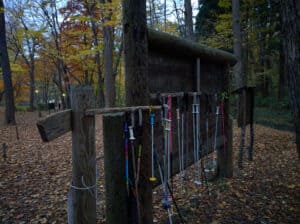Ever wondered how to use hiking pole tips? I’m here to guide you through it. Hiking pole tips, often overlooked, can transform your hiking experience if used correctly. They’re not just for show – they’ve got a serious job to do.
In this article, we’ll dive into the world of hiking pole tips. You’ll learn how to use them effectively to enhance your stability, reduce impact on your joints, and even improve your speed on the trails. Whether you’re a seasoned hiker or just starting out, you’ll find these tips invaluable.
So strap on your hiking boots, grab your poles and let’s get started. I promise by the end of this article, you’ll be using your hiking pole tips like a pro. You won’t just be walking the trails – you’ll be mastering them.
What are Hiking Pole Tips?

Let me break it down for you. Hiking pole tips are the points at the bottom end of your hiking poles. They contact the ground and offer stability and grip while you conquer those trails.
Primarily they’re crafted from durable materials like carbide or steel to endure rough terrains. Many pole tips come with additional features, like replaceable rubber caps for protection against wear and tear. It’s important to reiterate these are not just an aesthetic add-on, they’re a crucial part of the whole hiking pole ensemble.
- Different Types of Hiking Pole Tips
When it comes to hiking pole tips, one size does not fit all. These tips may differ based on the type of terrain they’re designed for: - Carbide or Steel Tips: These are ideal for almost all types of terrain, especially rocky or hard surfaces. Compelling by their robustness, they offer excellent durability and traction.
Imagine going on a hike without optimal pole tips — it’s like trying to walk on ice with smooth-soled shoes! Using the appropriate hiking pole tips makes the experience safer and more enjoyable. It not only boosts your stability but also reduces the impact on your joints and improves your speed on the trail.
So next time when you strap on your boots and grab your poles, remember the significance of those little tips at the end of your hiking poles. In our next section, we’ll dive into how to use these tips effectively to amplify your hiking prowess.
Why are Hiking Pole Tips Important?
Let’s dive right in. Imagine you are walking on a slippery, loose gravel trail. Without the right hiking pole tips, it’s not only challenging to maintain stability but also dangerous. Using the appropriate hiking pole tips can greatly improve your control and comfort, ensuring a safer and more enjoyable hiking experience.
Hiking pole tips play an integral role in providing stability. They dig into the ground, providing more traction and support. This is crucial when you’re trekking over uneven terrains. It also reduces the issue of slipping, especially on surfaces like smooth rocks, loose sand, snow, or ice. The extra traction can significantly minimize the risk of falls and injuries.
Another fundamental aspect of utilizing hiking pole tips lies in minimizing the impact on your joints. Each time your pole strikes the ground, it absorbs a portion of the shock that might otherwise travel up your arm. This feature is supremely beneficial for long hikes or descents, as it significantly reduces the strain on your knees, hips, and lower back, enhancing your endurance.
Lastly, you’ll love how using the correct hiking pole tips increases your speed on rolling or flat terrains. By providing extra push-off, they can increase your speed and efficiency, enabling you to cover more ground faster.
There are different types of hiking pole tips such as carbide or steel tips, rubber tips, and rubber walking tips or caps. Each type is designed specifically for different hiking conditions. Selecting the correct type can further enhance stability, comfort and hiking speed. Here, the importance of understanding your hiking pole tips can’t be overstated.
Don’t forget – wisely investing time in learning about your hiking pole tips can ensure a safer, more comfortable and faster hiking experience. So, it’s definitely worth getting to know your gear. I’m guessing you’re now keen to know how to use them effectively. That’s what we’ll delve into in our next segment.
Choosing the Right Hiking Pole Tips

When it comes to selecting the appropriate hiking pole tips, a few crucial factors come into play. Durability, functionality, and the type of terrain you’ll be hiking are among the top considerations.
Opting for carbide or tungsten tips is a smart choice for most hikers. Carbide tips provide superior durability and traction, making them ideal for rocky or icy terrain. Tungsten, on the other hand, is even tougher and more resistant to wear and tear. It’s often the first choice for experienced trekkers who traverse challenging terrains regularly.
Yet, the type of tip is only one part of the equation. Equally important it’s the design of the tip. Some tips are more suited to specific terrains than others. For example:
- Boot tips are perfect for muddy grounds as they prevent the pole from sinking into the mud.
- Pointed tips are ideal for rocky terrain as they can grip into small crevices.
- Wide baskets, found on snow tips, stop the pole from sinking into soft snow or sand.
After analyzing the terrain and judging your requirements, you’ll be better equipped to choose the perfect tips for your hiking poles. This insight will enhance your hiking experience, offer better support, and ensure that you move confidently across different terrains.
Now that we’ve covered how to pick the right pole tips, let’s dive into learning how to use them effectively on the trail. With the right technique, you can enhance your hiking experience, reduce joint stress, and improve your trail speed.
Proper Technique for Using Hiking Pole Tips
Hiking pole technique is just as crucial as choosing the right tips. Done correctly, it helps conserve energy, provides stability, and ameliorates your overall hiking experience. It’s essential to familiarize yourself with some fundamental techniques for proper use of your hiking poles.
The Correct Grip
Gripping your hiking pole correctly is foundational. You don’t want your grip too tight; that’ll only waste energy and possibly induce discomfort. Imagine holding a delicate bird, firm enough to prevent escape, yet gentle enough not to harm it. That’s the type of hold you’re aiming for. Power grips and loose straps aren’t optimal for pole use – keep the strap snug around your wrist.
Walking With the Poles
The rhythm and manner of swing while walking can make a significant difference. Strive for a rhythm that’s natural and syncs with your stride.
Hiking on a flat surface Alternate pole use with foot stride. If your left foot moves forwards, your right pole does too, and vice versa. Offering an enhanced sense of balance, this technique resembles Nordic walking.
Ascending or Descending Steeper Terrain When going uphill, your poles may feel more effective when both are placed in front and you push up from them. For steep descents, try putting both poles in front of you, leaning onto them rather than your joints.
Adapting to Terrain
Understanding how to adjust pole length for various terrain can greatly enhance stability. Reduce pole length when going uphill and increase it when descending. For traversing slopes, the uphill pole should be shorter than the downhill one.
Tips Specific Use
Remember to adjust tip use per the terrain. Carbide tips, great for rocky or icy terrain, boot tips work well for muddy trails, and wide baskets are excellent for snow or sand.
Advanced Techniques for Hiking Pole Tips

As we dive deeper into the topic, it’s important to understand there’s a lot more to using a hiking pole than just holding it right and marching forward. When you’ve really come to grips with basic techniques, it’s time to move on to some more advanced maneuvers.
Maintaining Proper Form sits at the top of the list when discussing advanced techniques for hiking pole tips. It’s not just about providing stability anymore; it’s about enhancing your efficiency on the trails.
Using Your Wrist Straps Wisely
Your wrist straps are there for more than just decoration. Feeding your hand up through the bottom of the strap and placing your thumb on the backside of the grip helps distribute weight between your arms and reduces the pressure on your hands. By doing this, you’re balancing the workload between your upper and lower body which ultimately conserves your precious energy.
Mastering the “Double Plant” on Steep Downhills
The ‘double plant’ technique comes in handy when dealing with steep trails. To perform a double plant, simultaneously plant both poles ahead of you while bending your knees. This provides extra support and thereby minimizes the risk of falling or straining your muscles. Utilize it on rocky or icy terrain to make hiking a breeze.
Optimizing Basket Use for Snow and Sand
The “wide basket” method proves itself exceptionally helpful in shallow snow and sandy conditions. Wide baskets distribute the pole’s weight over a broader area, preventing the pole from sinking too deep. This eventually saves a significant amount of effort. While trekking through deeper snow, lift the pole out of the snow rather than pushing it out backward, preventing the accumulation of snow on the baskets.
Conclusion: How to Use Hiking Pole Tips
I’ve shared some advanced techniques on using hiking pole tips. Remember, it’s all about maintaining proper form and efficiency on the trails. Using wrist straps can help distribute weight and reduce hand pressure, making your hike easier and more enjoyable.
Steep downhill trails? No problem. The “double plant” technique is your best friend. It enhances stability and helps conserve energy.
And don’t forget about optimizing basket use. It’s not just for snow and sand conditions. It can make a big difference in various terrains.
So, next time you’re out on the trail, give these techniques a try. They could turn your good hike into a great one. Happy hiking!
Other suggested articles:

